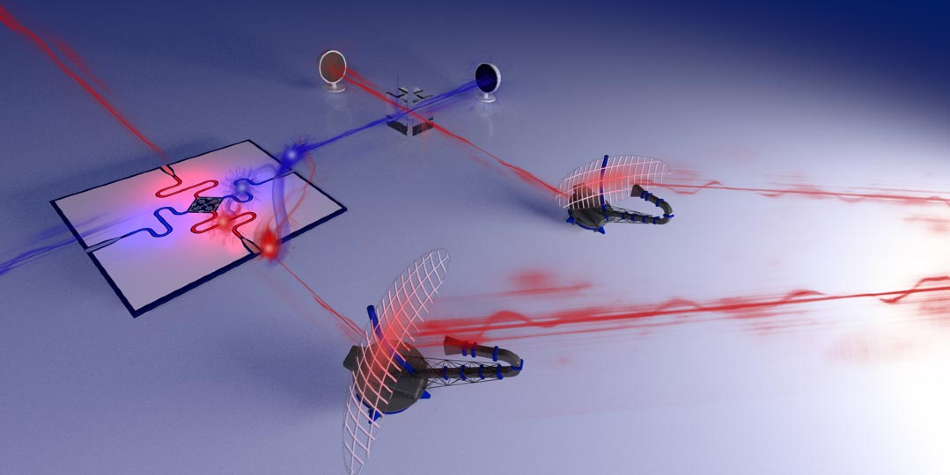May 11 2020
At the Institute of Science and Technology Austria (IST Austria), physicists have developed a new radar prototype that involves using quantum entanglement as a technique for object detection.
 Illustration of a quantum radar prototype. Image Credit: © IST Austria/Philip Krantz.
Illustration of a quantum radar prototype. Image Credit: © IST Austria/Philip Krantz.
Such an effective integration of quantum mechanics into devices used every day could considerably influence the security and biomedical industries. The study has been reported in the Science Advances journal.
Quantum entanglement can be described as a physical phenomenon in which two particles stay inter-connected, where they share physical traits irrespective of the distance between them.
At present, researchers from the group of Professor Johannes Fink at IST Austria—together with collaborators Stefano Pirandola from the Massachusetts Institute of Technology (MIT) and the University of York, UK, and David Vitali from the University of Camerino, Italy—have demonstrated a novel kind of detection technology named “microwave quantum illumination” that involves the use of entangled microwave photons as a detection method.
The prototype, also called “quantum radar,” can detect objects in noisy thermal environments, where classical radar systems usually fail. The technology could be used in applications for ultra-low-power biomedical imaging and security scanners.
Using Quantum Entanglement as a New Form of Detection
The device works based on simple principles: rather than using traditional microwaves, two groups of photons, known as the “signal” and “idler” photons, are entangled. The “signal” photons are directed toward the to-be-detected object, and the “idler” photons are quantified in relative isolation, free from noise and interference.
Once the signal photons are reflected back, real entanglement between the idler and signal photons gets lost. However, a small magnitude of correlation remains, which forms a pattern or signature that characterizes the absence or existence of the target object, regardless of the noise in the environment.
What we have demonstrated is a proof of concept for Microwave Quantum Radar. Using entanglement generated at a few thousandths of a degree above absolute zero (-273.14 °C), we have been able to detect low reflectivity objects at room-temperature.
Shabir Barzanjeh, Study Lead Author, Institute of Science and Technology Austria
At the time of the research project, Barzanjeh was a postdoc in the Fink group, whose previous study helped advance the theory behind quantum-enhanced radar technology. At present, Barzanjeh is an Assistant Professor at the University of Calgary.
Quantum Technology can Outperform Classical Low-Power Radar
Although quantum entanglement is, in itself, weak in nature, the device exhibits a few benefits over traditional classical radars. For example, at low power levels, traditional radar systems are usually affected by poor sensitivity as they find it difficult to differentiate between the radiation reflected by the object from background radiation noise that occurs naturally.
Quantum illumination enables solving this problem as the likeness of the “idler” and “signal” photons—produced by quantum entanglement—renders it highly effective to differentiate the signal photons (from the to-be-detected object) from the noise produced in the environment.
The main message behind our research is that ‘quantum radar’ or ‘quantum microwave illumination’ is not only possible in theory but also in practice. When benchmarked against classical low-power detectors in the same conditions we already see, at very low-signal photon numbers, that quantum-enhanced detection can be superior.
Shabir Barzanjeh, Study Lead Author, Institute of Science and Technology Austria
Prominent Milestone Towards Advancing 80-Year-Old Radar Technology
Fundamental science has been one of the main drivers of a paradigm shift, innovation, and technological advancement throughout history. Although the group’s study is only at the proof-of-concept stage, it has effectively unraveled a new detection technique that, in certain cases, could already be superior to classical radar.
“Throughout history, proof of concepts such as the one we have demonstrated here have often served as prominent milestones towards future technological advancements. It will be interesting to see the future implications of this research, particularly for short-range microwave sensors,” added Barzanjeh.
This scientific result was only possible by bringing together theoretical and experimental physicists that are driven by the curiosity of how quantum mechanics can help to push the fundamental limits of sensing. But to show an advantage in practical situations we will also need the help of experienced electrical engineers and there still remains a lot of work to be done in order to make our result applicable to real-world detection tasks.
Johannes Fink, Study Last Author and Professor, Institute of Science and Technology Austria
Journal Reference:
Barzanjeh, S., et al. (2020) Microwave quantum illumination using a digital receiver. Science Advances. doi.org/10.1126/sciadv.abb0451.